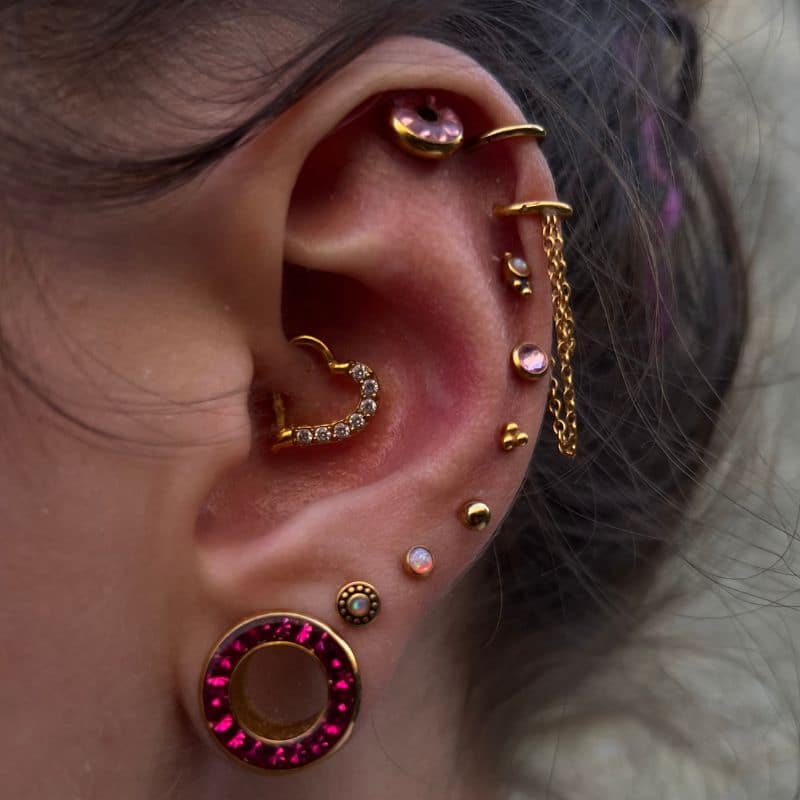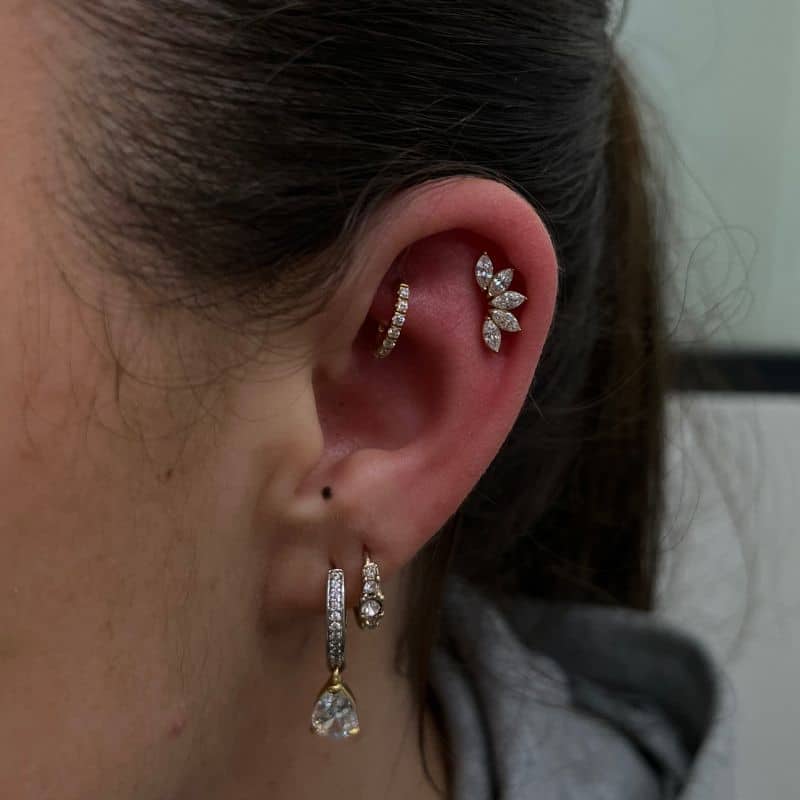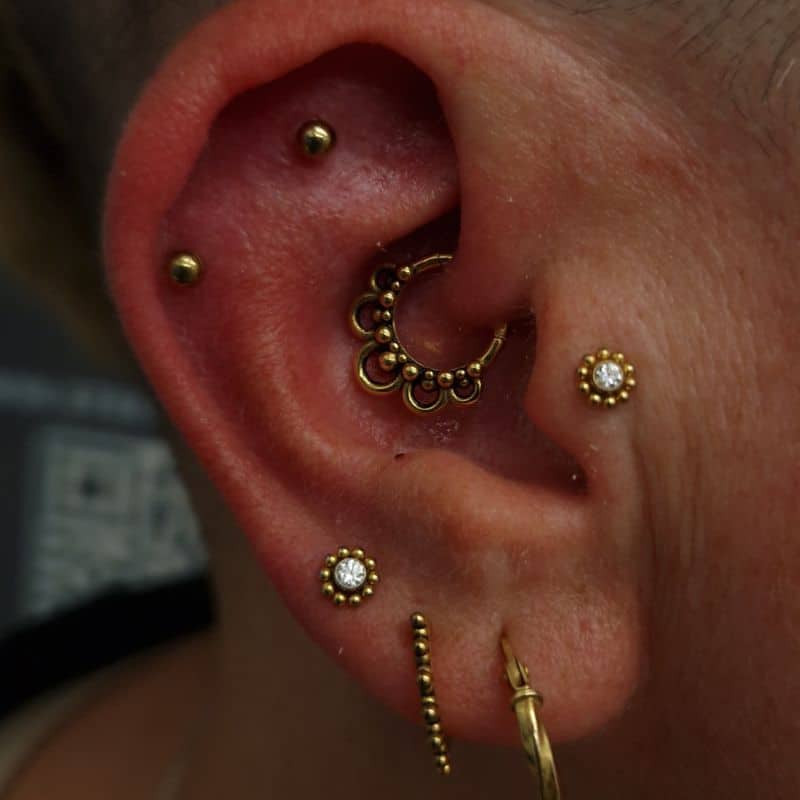Discover the ear piercings
Explore the beauty and elegance of ear piercings. Learn more about the process, styles and care to make an informed decision about your next piercing.
Introduction to ear piercings
Different ear piercing variations:
- Lobe (ear piercing): This is the most common type of ear piercing and is pierced at the lower edge of the earlobe.
- High lobe piercing: This piercing is located at the upper edge of the earlobe, close to the cartilage.
- Tragus piercing: The piercing is pierced on the tragus, the small cartilaginous protrusion in front of the ear canal.
- Industrial piercing: Two piercings are pierced through the upper cartilage of the ear and connected with a barbell.
- Conch piercing: This piercing is located in the inner auricle, the large cartilage structure on the ear.
- Helix piercing: A helix piercing is pierced on the upper edge of the ear, on the cartilage. There are different types of helix piercings, e.g. Forward Helix, Flat and Anti Helix.
- Rook piercing: A Piercing that is pierced vertically through the Rook cartilage. This runs horizontally slightly above the ear canal.
- Daith piercing: The piercing is located on the daith, the thick cartilage fold that partially covers the ear canal.

Ear piercing styles
Gallery of ear piercings
All about ear piercings
Ear piercings: Everything you need to know
History:
Ear piercings have a long and fascinating history dating back to ancient times. Archaeological finds prove that people pierced their ears to wear jewelry over 7,000 years ago.
More about the history here: History of ear piercings.
Different ear piercing variations:
- Lobe (ear piercing): This is the most common type of ear piercing and is pierced at the lower edge of the earlobe.
- High lobe piercing: This piercing is located at the upper edge of the earlobe, close to the cartilage.
- Tragus piercing: The piercing is pierced on the tragus, the small cartilaginous protrusion in front of the ear canal.
- Industrial piercing: Two piercings are pierced through the upper cartilage of the ear and connected with a barbell.
- Conch piercing: This piercing is located in the inner auricle, the large cartilage structure on the ear.
- Helix piercing: A helix piercing is pierced on the upper edge of the ear, on the cartilage. There are different types of helix piercings, e.g. Forward Helix, Flat and Anti Helix.
- Rook piercing: A Piercing that is pierced vertically through the Rook cartilage. This runs horizontally slightly above the ear canal.
- Daith piercing: The piercing is located on the daith, the thick cartilage fold that partially covers the ear canal.
Jewelry:
Various types of jewelry are used for ear piercings, the most common being:
- Labret plug: Plug with flat plate.
- BCR (Ball Closure Ring): Rings with a ball that is inserted into the ring.
- Segment Ring: Completely closed rings without balls. Closed with hinge or segment piece.
- CBB (Circular Barbell): Horseshoe-shaped rings with two balls.
- Barbell: Bars with balls at both ends.
- Banana: Curved Bars with balls at both ends.
- Stud earrings: Classic stud earrings with butterfly or silicone closure, only suitable for lobe piercings.
- Clicker: Rings with decoration such as cubic zirconia, patterns, snakes etc.
- InternalInternally threaded jewelry with decoration, shapes, patterns etc.
Healing time:
- Lobe ( ear hole ): Usually heal the fastest and take 4 to 6 weeks. to 6 weeks.
- Cartilage piercings: Take longer to heal due to the poorer blood supply to the cartilage, 3 to 6 months are normal, but it can also take up to 12 months or longer.
Material:
- High-quality jewelry made from sterilized material such as Bioplast, Surgical Steel 316L or Titanium G23 heals faster than inferior jewelry.
Aftercare:
- Careful cleaning the piercing and the surrounding area 3-5 times a day with our Piercing Care Spray.
Individual factors:
- Health and immune system: People with a strong immune system generally heal faster.
- Stress: Stress can slow down healing.
- Other factors: Smoking, excessive alcohol consumption and diabetes can also impair healing.
In general:
- The first 4 to 6 weeks: During this time, the piercing is particularly susceptible to infection. It is importantnot to touch the piercing and to keep the surrounding area clean.
- After 3 to 4 months: The piercing should be largely healed, but must continue to be cleaned and swept.
- After 6 months: It can take up to 6 months until the skin around the piercing until the skin around the piercing is as resistant as before the piercing.
Dangers and complications:
As with any piercing, there is a risk of infection, allergic reactions and scarring with an ear piercing. It is important to be pierced by a professional piercer and to use high-quality jewelry to minimize these risks.
Recommendations for care:
- Disinfect the piercing 3-5 times a day with a suitable piercing spray. We recommend the use of our Stechwerk Care. We have achieved the best results with this piercing spray over the years.
- Avoid touching or pulling on the piercing. Please do not use Q-tips (cotton buds) for cleaning and use a clean handkerchief for crusts.
- Sleep on the other side of the head until the piercing has healed. Otherwise the piercing may become crooked and cause problems.
- Do not wear headphones or earplugs until the piercing has completely healed.
- Make sure that your hair does not touch the piercing if possible.
- If you are unsure about swelling, redness or pain, come and see us.
Additional information:
- Pain: The piercing of an ear piercing is usually associated with a short, sharp pain. Most people experience the pain as moderate.
- Costs: The cost of an ear piercing varies depending on the jewelry. Our prices start at CHF 30 including standard jewelry for lobes (pierced ears) and CHF 65 for all others. An industrial costs CHF 80 including standard jewelry.
- Jewelry change: Once the piercing has healed completely, you can change the jewelry. However, it is important to use high-quality jewelry to avoid infection.
Conclusion:
Ear piercings are a popular way of expressing your own style. They are relatively painless and heal well if cared for properly. If you are considering an ear piercing, you should seek advice from a professional piercer and have the Care instructions follow exactly.
Are you ready for your ear piercing?
Our experienced team at Stechwerk is here to provide you with a safe and professional piercing experience. Contact us now if you have any questions.








